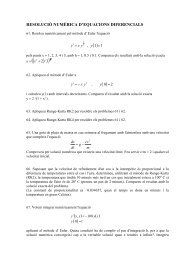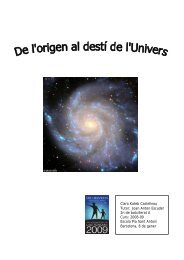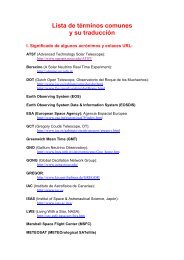Universitat de - Departament d'Astronomia i Meteorologia ...
Universitat de - Departament d'Astronomia i Meteorologia ...
Universitat de - Departament d'Astronomia i Meteorologia ...
Create successful ePaper yourself
Turn your PDF publications into a flip-book with our unique Google optimized e-Paper software.
3.6. Discussion 111<br />
At this point we might ask what is the point of studying runaway microquasars.<br />
In the case of LS 5039, if the SN explosion had taken place recently, we could expect<br />
the system to survive for the following ∼ 5 Myr, because the O6.5 star is still in<br />
the main sequence. Hence, according to the computed trajectory, it would reach<br />
a height of Z −600 pc, which translates into b −12 ◦ . On the other hand,<br />
LS 5039 could be associated with the high energy γ-ray source 3EG J1824−1514,<br />
as suggested by Pare<strong>de</strong>s et al. (2000). Hence, if this association is correct, we could<br />
be able to <strong>de</strong>tect γ-ray microquasars up to values of |b| > 10 ◦ , although practically<br />
all confirmed microquasars lie within |b| < 5 ◦ . In particular, runaway microquasars<br />
could be connected with some of the uni<strong>de</strong>ntified faint, variable, and soft γ-ray<br />
EGRET sources above/below the galactic plane, as suggested by Romero (2001)<br />
and Mirabel et al. (2001).<br />
Hence, it would be interesting to study the proper motions and radial velocities<br />
of as many microquasars as possible. Unfortunately, this kind of information is not<br />
easy to obtain for a wi<strong>de</strong> sample of systems. Proper motions can be obtained either<br />
from optical data or either from radio data. However, most optical counterparts<br />
of these sources are faint objects not present in old astrometric catalogs. Hence, it<br />
is mandatory to acquire new positions. In this context, it is better to do it in the<br />
radio domain because the uncertainties are always smaller than those obtained in<br />
the optical. On the other hand, it is necessary to carry out optical spectroscopy to<br />
obtain the radial velocity curve of these sources and use the correct value for the<br />
radial velocity of the system.<br />
An alternative approach could be the search for signatures of bow shocks in the<br />
microquasar vicinity. However, recent studies by Huthoff & Kaper (2002) of runaway<br />
OB stars, reveal that the success of this method is highly <strong>de</strong>pendant on the <strong>de</strong>nsity<br />
of the ISM around the runaway object. In particular, in only one object, namely<br />
Vela X-1, a bow shock has been <strong>de</strong>tected. Finally, one could search for signatures<br />
of explosive events in the ISM. Sensitive spectral line observations in the radio are<br />
probably the best tool for this purpose, as done in GRO J1655−40 by Combi et al.<br />
(2001).<br />
In any case, the study of runaway microquasars such as LS 5039 is likely to<br />
contribute significantly to different areas of mo<strong>de</strong>rn high-energy Astrophysics with<br />
in<strong>de</strong>pen<strong>de</strong>nce of the observing technique.






